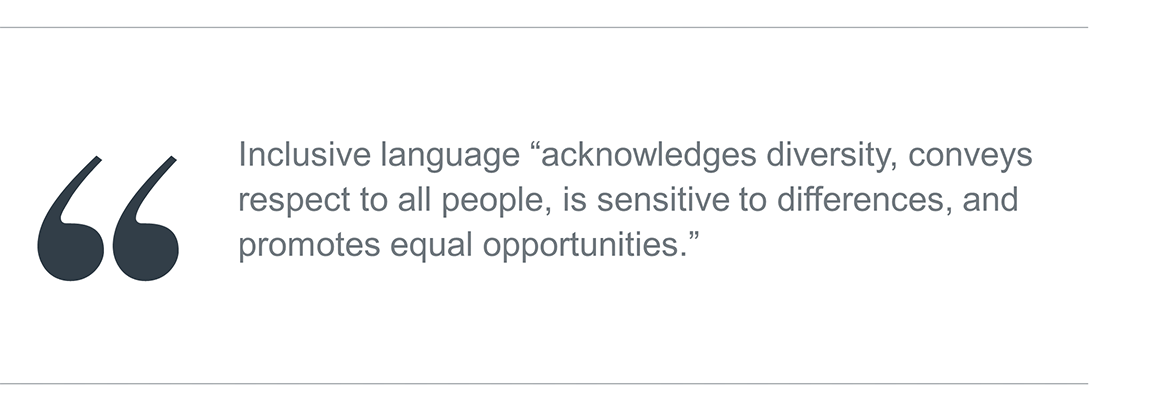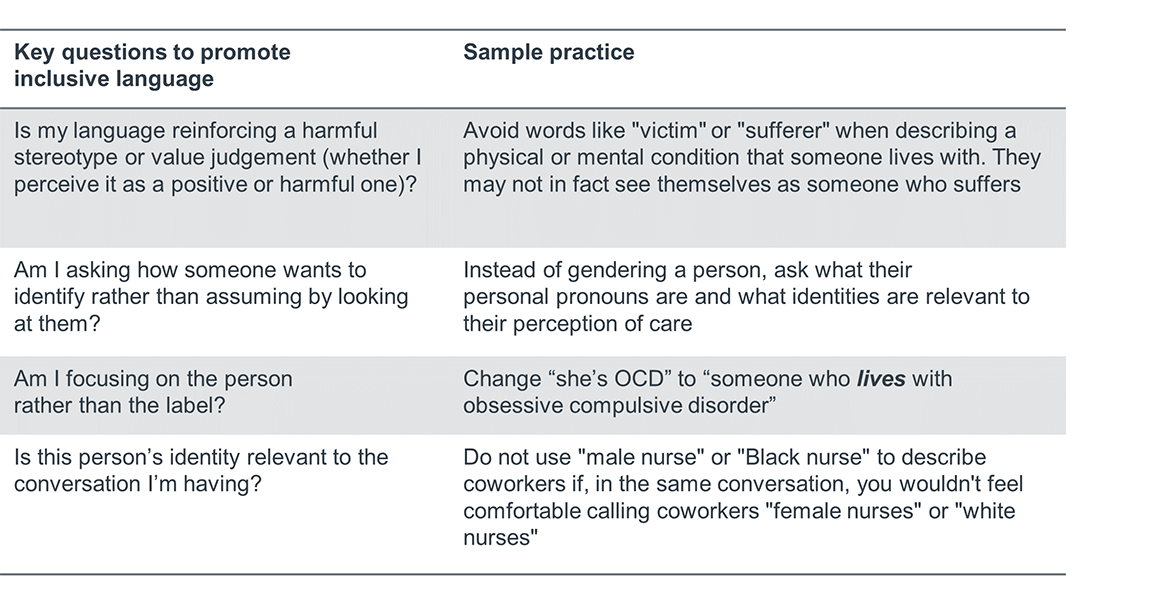Auto logout in seconds.
Continue LogoutKey Takeaways
- Organizations should use inclusive language to make employees of all identities feel seen and feel safe.
- Remember to remove, reword, or rethink language that stigmatizes marginalized groups.
- Consider what existing resources you can use to implement an inclusive language policy and look for opportunities to continuously improve your organization’s communication practices.
The language we use to communicate with colleagues and patients can have an impact on how people feel and behave. For this reason, organizations are increasingly encouraging the use of inclusive language in the workplace.

Inclusive language practices are a product of decades of protest and advocacy work led by marginalized groups through the feminist movement, disability rights movement, transgender rights movement, and HIV/AIDS activism, among others. As a result of their activism, we use gender-neutral terms like “flight attendant” or “legislator” instead of gendered nouns like “stewardess” or “congressman.” Or, instead of using terms like “handicapped” or “crippled,” we use “person with a disability.” What these activists have in common is a desire to transform discriminatory linguistic norms that marginalize certain identity groups.
It is important to note that inclusive language is not just about learning specific words to use (for example, asking people their personal pronouns). Inclusive language also means unlearning our tendency to make snap judgements about what labels we should use to describe someone’s identity in the first place. There is a natural inclination to categorize the people we interact with. However, when labels are used to describe someone's identity, people tend to make assumptions about them because of those labels. Those labels often allow us to group people into a monolithic experience that is not actually representative of their reality, ultimately perpetuating harmful stereotypes. Identity is never one-dimensional, generalizable, or static – and our language must reflect that.
Below are a few examples that illustrate what inclusive language looks like in practice.

Employee engagement and wellbeing
Failure to use inclusive language in the workplace can cause employees of historically marginalized identities to feel disengaged and/or incapable of focusing on their work. For example, one study found that women expected to feel more ostracized in the work environment and reported less motivation when presented with a job description with masculine gender-exclusive language (he in the generic form to refer to both men and women) rather than gender-neutral language (one in place of he). A different study found that the "misgendering" of transgender employees is "relatively common" in the workplace. However, when transgender participants were "asked to reflect on courageous acts coworkers had performed in support of the rights of trans employees," many of them "recalled instances in which a cisgender employee guided others on proper pronoun usage." These examples show how small acts of inclusive language can speak volumes to employees of marginalized identities by demonstrating that they are seen and valued in the workplace.
Patient wellbeing and outcomes
Using inclusive language with patients (i.e., being mindful of how you label them based on their identity or diagnosis) is one step providers can take to create a safe and validating environment for all patients. One study found that 30% of transgender patients report delaying or not seeking care due to fear of discrimination, and another report found that "transgender patients whose healthcare providers were uneducated on transgender issues were four times more likely to delay needed care." Providers may be "unwittingly [creating] an atmosphere of disapproval" for transgender patients through actions such as using a patient's birth name and gender rather than their preferred name and gender. Using inclusive language may demonstrate knowledge of transgender issues to patients.
In another example, higher-weight patients often report unsolicited, offensive comments about their weight from providers when accessing care for conditions unrelated to their weight, such as being called "morbidly obese" or having their weight described as "unhealthy" or "excess." "Disrespectful treatment and medical fat-shaming" can cause higher-weight patients to "delay health care seeking or avoid interacting with providers." Even though these providers may not intend to provoke harm, they are using labels for patients that carry harmful biases and serve to disengage, distance, and insult those that are frequently marginalized. Inclusive language can help alleviate some of this harm by ensuring that providers are mindful of the messages behind the labels they use.
Inclusive language practices should be one component of your organization’s overall commitment to inclusion and diversity. When beginning conversations around implementing inclusive language across your organization, consider starting out with a micro-shift that everyone can easily make. This will ease everyone into the process of creating a more inclusive workplace. Below are examples of micro-shifts that your organization can implement:
- Make changes in the language you use with your team. Kindly correct exclusionary language when you hear or read it. If an employee refers to someone as an “addict,” remind them to use person-centric alternatives such as “someone living with addiction.” Ask others to keep you accountable as well.
- Share resources with your team to help educate them on inclusive language practices. This guide from Northwestern University provides inclusive language recommendations and their exclusionary counterparts by topic area. Use these as a basis for conversation with your team about where you’re doing well and where you could improve.
- Edit your email signature to include the pronouns you use to identify yourself. Encourage others to do the same, but don’t pressure them if they would prefer not to say.
Once you have embedded these micro-shifts into the day-to-day work experience, the next step is to focus on a more comprehensive approach to using inclusive language. For example, review the language used in your organization’s employee handbooks, posters, internal newsletters, and patient education materials. Remember, inclusive language is not just about memorizing the right words but also accepting peoples’ differences and letting them define their own identity.
Conversations you should be having
Create policies or guidelines for use of inclusive language.
Train managers and leaders to use inclusive language.
Ensure internal and public-facing materials use inclusivelanguage.
Exclusionary language negatively impacts employee engagement and patient experience. As such, it’s important that inclusive language is codified by formal policies and trainings, and that these values are reflected in your organization’s internal and public-facing materials. In doing so, you are signaling to both employees and patients that they are in a space that celebrates difference and does not tolerate exclusionary practices.
Don't miss out on the latest Advisory Board insights
Create your free account to access 1 resource, including the latest research and webinars.
Want access without creating an account?
You have 1 free members-only resource remaining this month.
1 free members-only resources remaining
1 free members-only resources remaining
You've reached your limit of free insights
Become a member to access all of Advisory Board's resources, events, and experts
Never miss out on the latest innovative health care content tailored to you.
Benefits include:
You've reached your limit of free insights
Become a member to access all of Advisory Board's resources, events, and experts
Never miss out on the latest innovative health care content tailored to you.
Benefits include:
This content is available through your Curated Research partnership with Advisory Board. Click on ‘view this resource’ to read the full piece
Email ask@advisory.com to learn more
Click on ‘Become a Member’ to learn about the benefits of a Full-Access partnership with Advisory Board
Never miss out on the latest innovative health care content tailored to you.
Benefits Include:
This is for members only. Learn more.
Click on ‘Become a Member’ to learn about the benefits of a Full-Access partnership with Advisory Board
Never miss out on the latest innovative health care content tailored to you.
